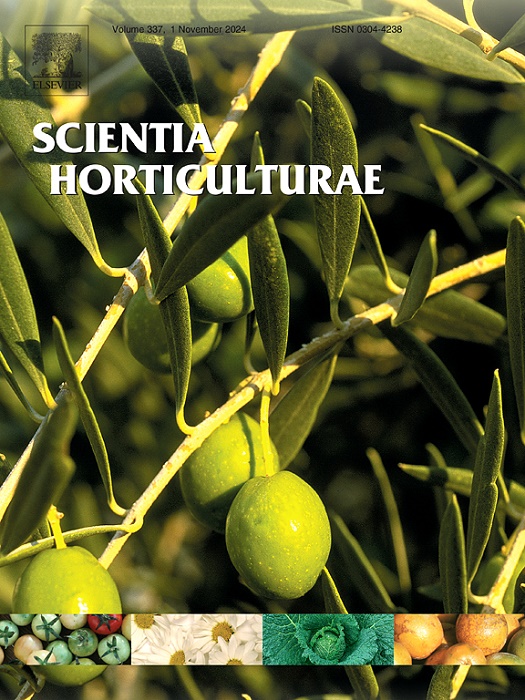The efficacy of soaking fresh-cut nectarines in melatonin concentrations and its effect on antioxidant capacity microbial content and storage quality
IF 4.2
2区 农林科学
Q1 HORTICULTURE
引用次数: 0
Abstract
The study aimed to identify the optimal concentration of exogenous melatonin for fresh-cut nectarines by evaluating their quality attributes during storage at 0 °C with relative humidity (RH) of 85 % - 90 % after treatments with different concentrations (0 mM, 0.05 mM, 0.1 mM, and 0.5 mM, with 0 mM as the control). Furthermore, the optimal melatonin treatment concentration and control were used to analyze its effects on antioxidant capacity and tissue microstructure of fresh-cut nectarines. The results indicated that 0.1 mM melatonin was the most effective treatment concentration for maintaining the primary physicochemical qualities of the fresh-cut nectarines. On 12 d of the storage, the 0.1 mM melatonin-treated group showed significant increases of 4.09 % in total phenolic content and 5.78 % in ascorbic acid compared to the control group, with more retained tissue microstructure. Additionally, the treatment was observed with a reduction of 23.82 % in MDA content, 39.31 % in H用褪黑激素浓度浸泡鲜切油桃的功效及其对抗氧化能力、微生物含量和贮藏质量的影响
该研究旨在确定外源褪黑激素在鲜切油桃中的最佳浓度,方法是在 0 °C 和相对湿度(RH)为 85 % - 90 % 的条件下贮藏期间,用不同浓度(0 mM、0.05 mM、0.1 mM 和 0.5 mM,0 mM 为对照)的褪黑激素处理后,评估其质量属性。此外,还利用最佳褪黑素处理浓度和对照组分析了其对鲜切油桃抗氧化能力和组织微观结构的影响。结果表明,0.1 mM 褪黑激素是保持鲜切油桃主要理化品质的最有效处理浓度。贮藏 12 天后,与对照组相比,0.1 mM 褪黑素处理组的总酚含量和抗坏血酸含量分别显著增加了 4.09 % 和 5.78 %,组织微观结构也得到了更好的保持。此外,与对照组相比,治疗组的 MDA 含量降低了 23.82%,H2O2 含量降低了 39.31%,超氧阴离子含量降低了 34.26%。此外,褪黑素还能抑制微生物的生长,提高鲜切油桃的抗氧化能力。此外,0.1 mM 褪黑激素处理降低了 POD 和 PPO 酶的基因表达和活性,而提高了 PAL 和 CHS 酶的基因表达和活性。这些研究结果表明,0.1 毫摩尔褪黑激素不仅能延缓鲜切油桃的褐变,还能提高其抗氧化能力和贮藏质量,突出了其作为一种有效的采后处理策略的潜力,从而减少商业应用中对合成防腐剂的依赖。
本文章由计算机程序翻译,如有差异,请以英文原文为准。
求助全文
约1分钟内获得全文
求助全文
来源期刊

Scientia Horticulturae
农林科学-园艺
CiteScore
8.60
自引率
4.70%
发文量
796
审稿时长
47 days
期刊介绍:
Scientia Horticulturae is an international journal publishing research related to horticultural crops. Articles in the journal deal with open or protected production of vegetables, fruits, edible fungi and ornamentals under temperate, subtropical and tropical conditions. Papers in related areas (biochemistry, micropropagation, soil science, plant breeding, plant physiology, phytopathology, etc.) are considered, if they contain information of direct significance to horticulture. Papers on the technical aspects of horticulture (engineering, crop processing, storage, transport etc.) are accepted for publication only if they relate directly to the living product. In the case of plantation crops, those yielding a product that may be used fresh (e.g. tropical vegetables, citrus, bananas, and other fruits) will be considered, while those papers describing the processing of the product (e.g. rubber, tobacco, and quinine) will not. The scope of the journal includes all horticultural crops but does not include speciality crops such as, medicinal crops or forestry crops, such as bamboo. Basic molecular studies without any direct application in horticulture will not be considered for this journal.
 求助内容:
求助内容: 应助结果提醒方式:
应助结果提醒方式:


